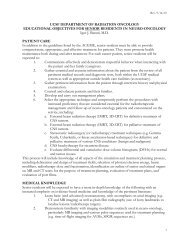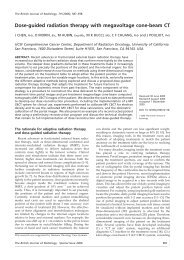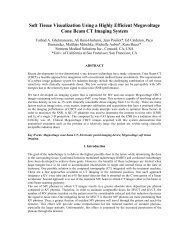A Comparison Of Intensity-Modulated Radiotherapy And Dynamic ...
A Comparison Of Intensity-Modulated Radiotherapy And Dynamic ...
A Comparison Of Intensity-Modulated Radiotherapy And Dynamic ...
You also want an ePaper? Increase the reach of your titles
YUMPU automatically turns print PDFs into web optimized ePapers that Google loves.
CLINICAL INVESTIGATION Brain<br />
STEREOTACTIC RADIOTHERAPY OF INTRACRANIALTUMORS: A COMPARISON OF<br />
INTENSITY-MODULATED RADIOTHERAPY AND DYNAMIC CONFORMAL ARC<br />
RUUD G. J. WIGGENRAAD, M.D.,* ANNA L. PETOUKHOVA, PH.D., y LIA VERSLUIS,* AND<br />
JAN P. C. VAN SANTVOORT, M.SC. y<br />
Departments of *<strong>Radiotherapy</strong> and y Medical Physics, Medical Center Haaglanden, The Hague, The Netherlands<br />
Purpose: <strong>Intensity</strong>-modulated radiotherapy (IMRT) and dynamic conformal arc (DCA) are two state-of-the-art<br />
techniques for linac-based stereotactic radiotherapy (SRT) using the micromultileaf collimator. The purpose of<br />
this planning study is to examine the relative merits of these techniques in the treatment of intracranial tumors.<br />
Materials and Methods: SRT treatment plans were made for 25 patients with a glioma or meningioma. For all patients,<br />
we made an IMRT and a DCA plan. Plans were evaluated using: target coverage, conformity index (CI),<br />
homogeneity index (HI), doses in critical structures, number of monitor units needed, and equivalent uniform<br />
dose (EUD) in planning target volume (PTV) and critical structures.<br />
Results: In the overall comparison of both techniques, we found adequate target coverage in all cases; a better<br />
mean CI with IMRT in concave tumors (p = 0.027); a better mean HI with DCA in meningiomas, complex tumors,<br />
and small (< 92 mL) tumors (p = 0.000, p = 0.005, and p = 0.005, respectively); and a higher EUD in the PTV with<br />
DCA in convex tumors (gliomas) and large tumors (p = 0.000 and p = 0.003, respectively). In all patients, significantly<br />
more monitor units were needed with IMRT. The results of the overall comparison did not enable us to predict<br />
the preference for one of the techniques in individual patients. The DCA plan was acceptable in 23 patients and<br />
the IMRT plan in 19 patients. DCA was preferred in 18 of 25 patients.<br />
Conclusions: DCA is our preferred SRT technique for most intracranial tumors. Tumor type, size, or shape do not<br />
predict a preference for DCA or IMRT. Ó 2009 Elsevier Inc.<br />
Stereotactic radiotherapy, <strong>Intensity</strong>-modulated radiotherapy, <strong>Dynamic</strong> conformal arc, Glioma, Meningioma.<br />
INTRODUCTION<br />
For more than a decade, stereotactic radiotherapy (SRT) has<br />
been standard treatment for several intracranial targets. The<br />
very high conformality makes it an attractive treatment option,<br />
specifically for solitary metastases, benign tumors, targets<br />
close to critical structures, and for reirradiation.<br />
Fractionated treatments have become a possibility with the<br />
development of linac-based SRT and relocatable head frames.<br />
At present, several treatment techniques are available in linacbased<br />
SRT, but in an individual case the best choice for one or<br />
other of these techniques is not always obvious, in spite of<br />
several planning studies that have been published (1–6).<br />
<strong>Dynamic</strong> conformal arc (DCA) and intensity-modulated<br />
radiotherapy (IMRT) techniques have become available in<br />
SRT with the introduction of the micromultileaf collimator.<br />
Two comparative planning studies conclude that DCA is to<br />
be preferred for small lesions up to 2 cm 3 (2, 3). Few studies,<br />
however, have addressed the relative merits of both techniques<br />
in the treatment of more complex intracranial tumors.<br />
For larger and irregularly shaped lesions, adequate treatment<br />
Reprint requests to: Ruud G.J. Wiggenraad, Medical Center Haaglanden,<br />
Department of Radiation Oncology, P.O. Box 432, 2501<br />
CK Den Haag, The Netherlands. Tel: (+31) 70 330 2013; Fax:<br />
(+31) 84 2211 526; E-mail: r.wiggenraad@mchaaglanden.nl<br />
doi:10.1016/j.ijrobp.2008.09.057<br />
1018<br />
Int. J. Radiation Oncology Biol. Phys., Vol. 74, No. 4, pp. 1018–1026, 2009<br />
Copyright Ó 2009 Elsevier Inc.<br />
Printed in the USA. All rights reserved<br />
0360-3016/09/$–see front matter<br />
plans can be made using IMRT, but the place of DCA in these<br />
situations needs further clarification. Moreover, these techniques<br />
differ in required workload for quality assurance<br />
and the generation of treatment plans (forward planning for<br />
DCA and inverse planning for IMRT).<br />
This planning study compares DCA and IMRT in intracranial<br />
targets. The purpose of this study is to determine if one of<br />
these techniques qualifies as best choice, given the anatomical<br />
characteristics of a tumor.<br />
MATERIALS AND METHODS<br />
Patients and prescribed treatment<br />
Twenty-five patients with intracranial tumors were selected for<br />
this study. We selected patients with targets with different sites,<br />
sizes, and shapes to be able to study the relative merits of IMRT<br />
and DCA in these different situations. As we wanted to focus on<br />
larger targets, we selected patients with a glioma or meningioma<br />
and a planning target volume (PTV) larger than 6 cm 3 .<br />
Table 1 shows the characteristics of the patients, the tumors, and<br />
the prescribed treatments. To be able to study the effect of the PTV<br />
Conflict of interest: none<br />
Acknowledgments—The authors are very grateful to J. van Egmond,<br />
A. Huls, and F. Bouricius for their support.<br />
Received Aug 22, 2008. Accepted for publication Sept 19, 2008.
Patient<br />
no. Gender Age Diagnosis Site<br />
Table 1. Characteristics of the patients, the tumors, and the prescribed treatments<br />
Planning target<br />
volume (mL)<br />
shape on the criteria for plan intercomparison, we classified the target<br />
shapes into three categories: convex, concave, and complex. All<br />
gliomas had a regular convex shape and all but one convexity meningiomas<br />
were concave. The base of skull meningiomas were all<br />
irregularly shaped, mostly because of extensions in the cavernous<br />
sinus and through foramina. This was also the case for a very complex<br />
frontal convexity meningioma that extended into the skull base.<br />
The shapes of these targets were classified as complex.<br />
To be able to study the effect of the PTV volume, we also classified<br />
the targets into two categories based on size: smaller and larger<br />
than the median volume of 92 mL.<br />
Treatment planning<br />
Each patient was scanned by computed tomography while fixed<br />
in the stereotactic head frame (BrainLAB AG, Feldkirchen, Germany).<br />
Scans were made with 2-mm slice thickness. A standard upper<br />
jaw support provided by Brainlab was used for patients without<br />
dentition and for most dentate patients, and a customized vacuum<br />
mouth piece was used for some dentate patients (7). All patients<br />
also had an MRI scan (voxel size 1.1 1.1 1.3 mm 3 ; T1-weighted<br />
with intravenous gadolinium and T2-weighted) of the brain. Coregistration<br />
of computed tomography and MRI was done on i-Plan<br />
RT Image version 3.0 (BrainLAB).<br />
All contouring was done on i-Plan RT Image version 3.0. The<br />
gross tumor volume (GTV) and the relevant critical structures<br />
IMRT and DCA in intracranial tumors d R. G. J. WIGGENRAAD et al. 1019<br />
Shape of<br />
target<br />
Prescribed<br />
dose<br />
Prescription<br />
isodose Critical structures<br />
1 M 46 Glioma<br />
(recurrence)<br />
Convexity 29 Convex 4 8 Gy 100% No<br />
2 M 45 Glioma<br />
(recurrence)<br />
Convexity 55 Convex 30 1.8 Gy 100% No<br />
3 M 57 Glioma<br />
(recurrence)<br />
Convexity 102 Convex 30 1.8 Gy 100% No<br />
4 M 52 Glioma Convexity 121 Convex 30 2 Gy 100% No<br />
5 M 61 Glioma Convexity 146 Convex 30 2 Gy 100% No<br />
6 F 68 Glioma Convexity 147 Convex 30 2 Gy 100% No<br />
7 M 67 Glioma Convexity 148 Convex 30 2 Gy 100% No<br />
8 F 55 Glioma Convexity 152 Convex 30 2 Gy 100% No<br />
9 M 62 Glioma Convexity 235 Convex 30 2 Gy 100% No<br />
10 F 37 Glioma Convexity 276 Convex 30 1.8 Gy 100% No<br />
11 M 62 Glioma Convexity 304 Convex 30 2 Gy 100% No<br />
12 M 41 Glioma Brainstem 85 Convex 28 2 Gy 100% No<br />
13 F 23 Glioma Brainstem 97 Convex 30 2 Gy 100% No<br />
14 F 40 Glioma Brainstem 146 Convex 30 1.8 Gy 100% No<br />
15 F 60 Meningioma Skull base 6 Complex 28 1.8 Gy 80% Optic nerve, chiasm<br />
16 M 76 Meningioma Skull base 8 Complex 5 5 Gy 80% Optic nerve, chiasm<br />
17 F 42 Meningioma Skull base 15 Complex 28 1.8 Gy 80% Optic nerve, chiasm<br />
brainstem<br />
18 F 72 Meningioma Skull base 15 Complex 28 1.8 Gy 80% Optic nerve, chiasm<br />
19 F 57 Meningioma Skull base 21 Complex 28 1.8 Gy 80% Optic nerve, chiasm<br />
20 F 38 Meningioma Convexity 48 Concave 28 1.8 Gy 80% No<br />
21 F 36 Meningioma<br />
(atypical)<br />
Convexity 66 Concave 30 1.8 Gy 80% No<br />
22 M 74 Meningioma<br />
(atypical)<br />
Convexity 81 Concave 30 1.8 Gy 80% No<br />
23 F 68 Meningioma Skull base 87 Complex 28 1.8 Gy 80% Optic nerve, chiasm<br />
24 F 62 Meningioma<br />
(atypical)<br />
Convexity 92 Complex 30 1.8 Gy 80% Optic nerve, chiasm<br />
25 F 37 Meningioma Skull base 142 Complex 28 1.8 Gy 80% Optic nerve, chiasm<br />
brainstem<br />
were contoured on contrast-enhanced MRI scans (T1-weighted<br />
MRI with intravenous gadolinium and T2-weighted MRI). In glioma<br />
patients, the clinical target volume (CTV) was formed by expanding<br />
the GTV with 15 mm, except in regions where natural<br />
boundaries precluded microscopic tumor spread. In meningioma patients,<br />
we did not use any GTV to CTV margin, assuming no microscopic<br />
spread beyond the visible tumor. The positioning accuracy of<br />
the mask system together with the use of the Exactrac system allows<br />
the use of a 2-mm margin between CTV and PTV (7). For patients in<br />
whom the CTV was in close contact with critical structures, the<br />
CTV-PTV margin was adapted manually to avoid overlapping of<br />
the PTV and these critical structures. Additionally, we contoured<br />
the total brain minus the PTV.<br />
All treatment plans were made on Brainscan 5.31 (BrainLAB).<br />
For every patient, two plans were made for comparison: an inversely<br />
planned IMRT plan and a forwardly planned DCA plan (Fig. 1, 2).<br />
Calculations of dose–volume histograms were done with a grid size<br />
of 2 mm. For small objects, an adaptive grid size was used.<br />
In DCA planning, the critical organs were avoided as much as possible<br />
by selecting the optimal table positions, arc angles, and leave positions<br />
using the beam’s-eye view. In IMRT planning, we did not use<br />
a standard set of dose–volume constraints for every patient. In our experience,<br />
adaptation of the dose–volume constraints on an individual<br />
basis enabled better avoidance of critical organs. Moreover, Brainscan<br />
always produces four different IMRT plans, each with a different
1020 I. J. Radiation Oncology d Biology d Physics Volume 74, Number 4, 2009<br />
Fig. 1. Example of the dose distribution of a patient with a small skull base tumor (Patient 15) with dynamic conformal arc<br />
(left) and intensity-modulated radiotherapy (right).<br />
balance between the importance given to PTV coverage and organ-atrisk<br />
sparing. For IMRT, manually optimized beam directions were<br />
used. The optimal number and orientation of the beams were determined<br />
by comparing IMRT plans with varying beam configurations.<br />
In all patients, four to six noncoplanar beams yielded a result that was<br />
optimal, combined with a realistic treatment time.<br />
Some of the patients were treated with DCA when IMRT was not<br />
yet used in clinical practice. For them, IMRT plans were made for<br />
this study after they had been treated. For most patients, both<br />
DCA and IMRT were available and they were treated according<br />
to the plan that was considered preferable.<br />
Plan comparison<br />
Criteria. Treatment plan intercomparisons were performed using<br />
the following criteria: target coverage, conformity index, homogeneity<br />
index, and dose in critical organs. To gain more insight into<br />
the effect of inhomogeneous dose distributions, the equivalent<br />
Fig. 2. Example of the dose distribution of a patient with a large skull base tumor (Patient 25) with dynamic conformal arc<br />
(left) and intensity-modulated radiotherapy (right).
coverage (%)<br />
102,00%<br />
100,00%<br />
98,00%<br />
96,00%<br />
94,00%<br />
92,00%<br />
90,00%<br />
1 3 5 7 9 11 13 15 17 19 21 23 25<br />
patient<br />
uniform dose (EUD) in the PTV and critical organs were derived<br />
from the dose–volume histogram (8). Furthermore, the number of<br />
monitor units necessary for each plan was recorded.<br />
In all plans, 100% of the dose was in the isocenter. Target coverage<br />
was defined as the percentage of the PTV covered by the 80%<br />
isodose in meningiomas and the 95% isodose in gliomas. The planning<br />
goal always was 100% target coverage; a coverage of less than<br />
95% was not accepted.<br />
The conformity index (CI) was defined as in Brainscan as:<br />
CI ¼ 1 þ Vn=Vt<br />
where V n is the volume of normal tissue receiving the prescribed<br />
dose and Vt is the volume of the target receiving the prescribed dose<br />
(or 95% of the prescribed dose in gliomas). The ideal CI is 1, a CI<br />
higher than 1.5 was considered insufficient, and a CI higher than<br />
2 was not accepted. As Vn, we used in this formula the volume of<br />
total brain minus PTV.<br />
The homogeneity index (HI) was defined for stereotactic radiotherapy<br />
as:<br />
HI ¼ Dmax=Dprescribed<br />
where Dmax and Dprescribed are the maximum and the prescribed<br />
dose, respectively. The ideal HI depends on the prescription isodose.<br />
When the dose is prescribed to the 80% isodose, the ideal HI is<br />
1.25. Following the principles of stereotactic radiotherapy, the HI<br />
should preferably be below 2; between 2 and 2.5 would be acceptable<br />
(9).<br />
Analogous with this, for the glioma plans that are prescribed to<br />
100% and for which the 95% isodose should encompass the PTV,<br />
we define the HI as:<br />
HI ¼ Dmax=D 95%<br />
DCA<br />
IMRT<br />
Fig. 3. The target coverage of both the dynamic conformal arc and<br />
the intensity-modulated radiotherapy plans.<br />
Dose prescription in gliomas was done using the International<br />
Commission on Radiation Units and Measurements (ICRU) criteria,<br />
because the CTV usually contains normal brain tissue where hotspots<br />
should be avoided. However, we accepted small hotspots<br />
(within 7% of the PTV) between 107% and 110%, with a corresponding<br />
HI value up to 1.16 (10).<br />
Only patients with meningiomas (who had the dose specified to<br />
the 80% isodose) had critical structures close to the target. Only<br />
the optic nerve closest to the PTV was considered. The other optic<br />
nerve either received a lower dose, or was not classified as a critical<br />
structure (in one patient who almost lost the vision of the left eye<br />
because of tumor encasement of the left optic nerve).<br />
As clinical dose constraints, we defined<br />
for the brainstem: 60 Gy maximum point dose and 56 Gy in not<br />
more than 2% of the volume.<br />
IMRT and DCA in intracranial tumors d R. G. J. WIGGENRAAD et al. 1021<br />
for the optic nerves and the optic chiasm: 56 Gy maximum point<br />
dose and 50 Gy in not more than 2% of the volume (or 25 Gy<br />
maximum point dose in the patient who received 5 5 Gy).<br />
However, the planning goal was always the lowest achievable<br />
dose in the critical organs.<br />
The EUD was calculated using the equation:<br />
EUD ¼ð1=N SiD a<br />
i Þ1=a<br />
where N is the number of voxels in the anatomic structure of<br />
interest, D i is the ith voxel, and a is the tumor or normal tissue-specific<br />
parameter describing the dose–volume effect (11).<br />
We used in the equation as parameter a: –8 for PTV, 4.6 for brainstem,<br />
and 7.4 for optic nerve and chiasm (8).<br />
The EUD in the PTV and organs at risk were calculated. In a comparison<br />
of different plans, the preferable plan is the one with the<br />
highest EUD for the PTV or the lowest EUD for normal tissue<br />
and critical structures.<br />
Overall comparison of the techniques<br />
The merits of both techniques were compared for the entire patient<br />
cohort. For this comparison, all mentioned criteria were used.<br />
The dose in the critical organs was only considered if it was unacceptably<br />
high. Furthermore, we compared the techniques according<br />
to the diagnosis (glioma or meningioma) and the size and shape of<br />
the target.<br />
Individual comparison of the techniques<br />
We also compared DCA with IMRT for each patient and classified<br />
the plans as acceptable or unacceptable, based on the previously<br />
mentioned criteria. All plans had been visually inspected and were<br />
judged as optimal for the applied technique. If both plans were acceptable,<br />
one of the techniques could be preferable in case of a clear<br />
difference with respect to one or more of the criteria. Our preference<br />
for one of the two plans was mostly based on the assessment of the<br />
CI, HI, and dose in the critical structures. A difference of the CI or<br />
the HI of more than 5% (of the mean value for DCA and IMRT) resulted<br />
in a preference for the technique with the best index, unless<br />
there was a difference in the dose in the critical structures that was<br />
considered clinically relevant. Our preference was based much<br />
less on visual inspection, which we did not find very useful for comparison<br />
of optimal plans, or target coverage. In cases without a clear<br />
difference between the plans, we preferred DCA.<br />
Statistics<br />
For the statistical analysis we used SPSS, version 16 (SPSS Inc.,<br />
Chicago, IL). To analyze the differences between the DCA and<br />
IMRT plans for each of the previously described criteria, a paired<br />
samples t test was used. The same method was applied to various<br />
groups of patients classified according to diagnosis, size, or shape<br />
of the PTV. The level of statistical significance was considered<br />
p < 0.05 for all calculations; therefore, a 95% confidence interval<br />
was applied.<br />
RESULTS<br />
Overall comparison of the techniques<br />
Target coverage. Figure 3 shows the target coverage of<br />
both the DCA and the IMRT plans of all patients. With<br />
both techniques, acceptable target coverage was possible in<br />
all patients. It was higher than 99% in every plan of the 14
1022 I. J. Radiation Oncology d Biology d Physics Volume 74, Number 4, 2009<br />
conformity index<br />
1,8<br />
1,6<br />
1,4<br />
1,2<br />
1,0<br />
0,8<br />
0,6<br />
0,4<br />
0,2<br />
0,0<br />
1 3 5 7 9 11 13 15 17 19 21 23 25<br />
patient<br />
DCA<br />
IMRT<br />
Fig. 4. The conformity indices of both the dynamic conformal arc<br />
and the intensity-modulated radiotherapy plans.<br />
glioma patients and higher than 96% in every plan of the 11<br />
meningioma patients. The mean coverage with the DCA and<br />
IMRT plans was 99.1% and 99.5%, respectively. This difference<br />
was statistically significant (p = 0.048).<br />
Conformity. Figure 4 shows the conformity index for total<br />
brain minus PTV of all patients using both treatment techniques.<br />
The CI of all patients was well below the value two<br />
with both techniques. Table 2 shows the relation of the CI<br />
to tumor type, shape, and size. For the entire patient group,<br />
there was no statistically significant difference between<br />
both techniques with respect to mean CI (p = 0.241). The<br />
mean CI in concave tumors was significantly better with<br />
IMRT (p = 0.027). However, only 3 patients had concave tumors;<br />
therefore, statistics should be interpreted with caution.<br />
Table 2. Overall comparison of the techniques<br />
Homogeneity index Conformity index<br />
DCA IMRT<br />
Homogeneity. Figure 5 shows all homogeneity indices<br />
and Table 2 shows the relation of the HI to tumor type, shape,<br />
and size. There was no statistically significant difference between<br />
the mean homogeneity indices of DCA and IMRT for<br />
all patients (p = 0.234). In meningiomas and complex-shaped<br />
tumors, the mean HI was significantly lower with DCA (p =<br />
0.000 and p = 0.005, respectively). In smaller tumors, DCA<br />
plans had a lower mean HI than IMRT, but in larger tumors<br />
there was no significant difference.<br />
EUD. Figure 6 shows the EUDs of the PTV and total brain<br />
minus PTV for all patients. Table 2 shows the relation of the<br />
EUD in the PTV to tumor type, shape, and size. For the entire<br />
patient group, no significant difference existed between the<br />
mean EUDs in the PTV of DCA and IMRT (p = 0.112). Convex<br />
tumors (the same cohort as the gliomas) and large tumors<br />
had a higher mean EUD with DCA than with IMRT (p =<br />
0.000, and p = 0.003, respectively).<br />
These were the categories without significant differences<br />
with respect to HI and CI.<br />
Organs at risk<br />
Table 3 shows the D max (maximum point dose), the D2,<br />
D30, D80 (dose exceeded in 2%, 30%, and 80% of the volume),<br />
and the EUD of the critical structures. In 3 patients<br />
(15, 18, and 25) neither technique completely matched the<br />
constraints. The mean EUD in the critical structures did not<br />
differ significantly between both techniques (Table 2).<br />
DCA IMRT<br />
Extrapolated uniform<br />
dose (Gy)<br />
DCA IMRT<br />
Mean (SD) Mean (SD) p Mean (SD) Mean (SD) p Mean (SD) Mean (SD)<br />
Entire patient<br />
group (n = 25)<br />
1.221 (0.083) 1.237 (0.126) 0.234 1.214 (0.100) 1.248 (0.157) 0.241 57.7 (9.5) 56.8 (9.7) 0.112<br />
Gliomas (n = 14) 1.154 (0.036) 1.130 (0.020) 0.095 1.186 (0.105) 1.175 (0.077) 0.573 57.7 (7.7) 56.0 (7.45) 0.000<br />
Meningiomas<br />
(n = 11)<br />
1.306 (0.023) 1.374 (0.030) 0.000 1.250 (0.086) 1.340 (0.186) 0.127 57.7 (11.9) 57.8 (12.3) 0.958<br />
Convex tumors<br />
(n = 14)<br />
1.154 (0.036) 1.130 (0.020) 0.095 1.186 (0.105) 1.175 (0.077) 0.573 57.7 (7.7) 56.0 (7.5) 0.000<br />
Complex shaped<br />
tumors (n = 8)<br />
1.304 (0.026) 1.364 (0.024) 0.005 1.236 (0.098) 1.383 (0.204) 0.056 55.3 (13.3) 54.9 (13.3) 0.782<br />
Concave tumors<br />
(n = 3)<br />
1.313 (0.015) 1.400 (0.035) 0.093 1.287 (0.025) 1.227 (0.029) 0.027 64.0 (2.2) 65.5 (3.5) 0.412<br />
Small tumors<br />
(
Homogeneity index<br />
1,6<br />
1,4<br />
1,2<br />
1,0<br />
0,8<br />
0,6<br />
0,4<br />
0,2<br />
0,0<br />
1 3 5 7 9 11 13 15 17 19 21 23 25<br />
patient<br />
DCA<br />
IMRT<br />
Fig. 5. The homogeneity indices of both the dynamic conformal arc<br />
and the intensity-modulated radiotherapy plans.<br />
Figure 7 shows the mean dose–volume histogram of brain<br />
minus PTV in both the DCA and the IMRT plans. There was<br />
no statistically significant difference between both techniques<br />
with respect to the dose in brain minus PTV (p =<br />
0.611).<br />
Monitor units<br />
For comparison of the plans, the IMRT/DCA ratio of the<br />
number of monitor units needed was recorded for each patient.<br />
The mean IMRT/DCA ratio of the number of monitor<br />
units was 2.2 (SD 0.4). In all patients, significantly more<br />
monitor units were needed for IMRT plans than for DCA<br />
plans.<br />
Individual comparison of the techniques<br />
Table 4 shows the comparison of the plans of all individual<br />
patients with both techniques. Based on this comparison,<br />
DCA was preferred in 18 patients and IMRT in 7 patients.<br />
Case PTV dose (Gy)<br />
IMRT and DCA in intracranial tumors d R. G. J. WIGGENRAAD et al. 1023<br />
EUD (Gy)<br />
80,0<br />
70,0<br />
60,0<br />
50,0<br />
40,0<br />
30,0<br />
20,0<br />
10,0<br />
0,0<br />
Table 3. Doses in the critical structures<br />
1 3 5 7 9 11 13 15 17 19 21 23 25<br />
patient<br />
We found that the preference for one of the techniques in<br />
the individual patients could not be predicted from the overall<br />
comparison based on diagnosis, shape, or size of the tumors.<br />
DISCUSSION<br />
EUD of PTV with<br />
DCA<br />
EUD of PTV with<br />
IMRT<br />
EUD of brain minus<br />
PTV with DCA<br />
EUD of brain minus<br />
PTV with IMRT<br />
Fig. 6. Equivalent uniform dose of the planning target volume<br />
(PTV) and total brain minus PTV with both the dynamic conformal<br />
arc and the intensity-modulated radiotherapy plans.<br />
This study compared IMRT and DCA in intracranial tumors<br />
of various sites, sizes, and shapes. In the overall comparison<br />
of both techniques, we found adequate target<br />
coverage in all cases and differences in mean CI, HI, and<br />
EUD in subgroups. In all patients, significantly more monitor<br />
units were needed for IMRT plans than for DCA plans. The<br />
DCA plan was acceptable in 23 patients and the IMRT plan in<br />
19 patients. DCA was preferred in 18 of the 25 patients.<br />
Only a few studies comparing DCA and IMRT for brain<br />
tumors have been published. Ding et al. performed a planning<br />
study in 15 patients comparing three-dimensional conformal<br />
Optic nerve Chiasm Brainstem<br />
D80 D30 D2 Dmax EUD (Gy) D80 D30 D2 Dmax EUD (Gy) 80 30 2 Dmax EUD (Gy)<br />
15 DCA 3.9 13.4 50.0 56.1 34.3 18.6 39.6 51.0 54.2 40.3<br />
IMRT 3.2 12.4 54.8 58.6 38.8 18.3 46.8 55.7 58.6 45.4<br />
16 DCA 0.5 10.8 17.2 20.9 10.1 6.4 9.8 15.9 18.1 9.3<br />
IMRT 0.9 10.3 16.6 20.3 9.7 4.0 8.8 15.2 17.8 8.8<br />
17 DCA 1.3 4.2 16.4 25.8 12.3 12.9 31.2 41.7 45.4 32.0 17.2 31.1 47.0 52.9 32.0<br />
IMRT 3.2 10.7 32.4 38.4 23.0 10.0 29.1 48.4 52.9 35.5 5.2 12.9 40.3 50.4 23.0<br />
18 DCA 4.5 37.2 52.0 56.7 39.3 25.8 35.5 45.6 50.4 36.1<br />
IMRT 8.4 39.7 54.3 58.0 42.1 14.7 28.9 47.3 52.9 34.3<br />
19 DCA 2.6 5.9 41.0 46.0 27.9 17.6 28.9 42.2 47.3 31.7<br />
IMRT 10.4 17.0 50.8 54.8 34.4 10.1 26.9 43.7 48.5 32.5<br />
23 DCA 38.4 44.0 47.7 49.8 43.0 20.3 24.9 31.7 34.0 25.4<br />
IMRT 9.5 29.6 42.6 47.3 32.0 5.0 6.8 10.7 14.5 8.2<br />
24 DCA 18.9 32.0 47.3 51.3 35.2 22.1 25.7 31.1 33.1 25.8<br />
IMRT 19.9 30.2 47.9 57.4 35.1 16.3 19.9 28.3 31.7 21.5<br />
25 DCA 15.3 25.5 38.9 44.7 28.5 43.1 47.3 51.7 54.2 46.7 26.6 41.2 51.7 60.5 39.3<br />
IMRT 8.9 12.4 29.3 40.3 21.2 44.1 50.0 55.1 57.3 49.0 20.2 41.7 55.9 61.1 40.6<br />
Abbreviations: DCA = dynamic conformal arc; Dmax = maximum point dose; D2 = dose exceeded in 2% of the volume of the structure; D30 =<br />
dose exceeded in 30% of the volume of the structure; D 80 = dose exceeded in 80% of the volume of the structure; IMRT = intensity-modulated<br />
radiotherapy; PTV = planning target volume.<br />
Values that do not match the constraints are in bold.
1024 I. J. Radiation Oncology d Biology d Physics Volume 74, Number 4, 2009<br />
Volume percentage (%)<br />
100,00<br />
90,00<br />
80,00<br />
70,00<br />
60,00<br />
50,00<br />
40,00<br />
30,00<br />
20,00<br />
10,00<br />
0,00<br />
0 20 40 60 80 100 120<br />
Dose percentage (%)<br />
DCA<br />
IMRT<br />
Fig. 7. Mean dose–volume histogram of brain minus planning target<br />
volume in both the dynamic conformal arc and the intensitymodulated<br />
radiotherapy plans.<br />
radiotherapy, DCA, and IMRT for stereotactic brain tumor<br />
treatment (3). The authors’ conclusion is similar to ours,<br />
namely that DCA is suitable for most cases in stereotactic<br />
brain tumor treatment. However, we do not agree with their<br />
conclusion that IMRT plans are the best in larger tumors.<br />
Their results in tumors larger than 100 mL are based on<br />
only 2 patients, whereas we studied 11 patients with tumors<br />
larger than 100 mL.<br />
Patient<br />
Coverage<br />
DCA<br />
Coverage<br />
IMRT<br />
CI<br />
DCA<br />
Table 4. Plan comparison for all individual patients<br />
CI<br />
IMRT<br />
HI<br />
DCA<br />
HI<br />
IMRT<br />
The group of the University of Erlangen compared DCA<br />
and IMRT in pituitary tumors and small skull base tumors<br />
(1, 2). They concluded that DCA was to be preferred in these<br />
small skull base tumors (until 10.4 cm 3 ) (2). However, for<br />
pituitary tumors, IMRT was superior in their hands (1). The<br />
discrepancy between the conclusions in both papers is not<br />
fully explained. Because DCA is a forwardly planned technique,<br />
the experience of the planner to some extent determines<br />
the quality of the plan and thus also influences the<br />
result of a comparative planning study.<br />
IMRT and DCA have both been compared with other stereotactic<br />
techniques in brain tumors. Perks et al. compared<br />
DCA with gamma knife radiosurgery in acoustic neuromas<br />
(12). They found a slightly better conformity index for<br />
gamma knife, but a more homogeneous dose distribution<br />
for DCA. They concluded that both techniques had advantages<br />
and disadvantages. Nakamura et al. compared gamma<br />
knife radiosurgery with IMRT in small and medium sized<br />
skull base tumors (13). They found that IMRT was better<br />
in almost all aspects. Baumert et al. compared IMRT with<br />
conformal beam in skull base meningiomas (6). IMRT was<br />
superior in almost all aspects, especially in large and irregular<br />
targets. IMRT was also compared with tomotherapy; neither<br />
technique seemed clearly superior to the other (4, 14).<br />
In our opinion, dose homogeneity is an important aspect of<br />
plan quality, although it does not always receive attention in<br />
Critical<br />
structures DCA<br />
Critical<br />
structures IMRT<br />
Acceptable<br />
plan<br />
Preferred<br />
plan<br />
1 + + + + + + + + Both DCA<br />
2 + + + + + + + + Both IMRT<br />
3 + + + + + + + + Both DCA<br />
4 + + + + + + + + Both IMRT<br />
5 + + + + + + + + Both IMRT<br />
6 + + + + + + + + Both DCA<br />
7 + + + + + + + + Both DCA<br />
8 + + + + + + + + Both DCA<br />
9 + + + + – + + + IMRT IMRT<br />
10 + + + + – + + + IMRT IMRT<br />
11 + + + + + + + + Both DCA<br />
12 + + + + + + + + Both DCA<br />
13 + + + + + + + + Both DCA<br />
14 + + + + + + + + Both DCA<br />
15* + + + + + + – – None DCA<br />
16 + + + + + + + + Both DCA<br />
17 + + + – + + + + DCA DCA<br />
18* + + + + + + – – None DCA<br />
19 + + + – + + + – DCA DCA<br />
20 + + + + + + + + Both DCA<br />
21 + + + + + + + + Both IMRT<br />
22 + + + + + + + + Both DCA<br />
23 + + + + + + + + Both IMRT<br />
24 + + + + + + + – DCA DCA<br />
25* + + + + + + – – None DCA<br />
Abbreviations: DCA = dynamic conformal arc; IMRT = intensity-modulated radiotherapy; CI = conformity index.<br />
+Defined criteria or constraints are met.<br />
–Defined criteria or constraints are not met.<br />
* In Patients 15, 18, and 25, none of the techniques fully matched the dose constraints in the critical organs, but in all 3 patients DCA plan was<br />
accepted in clinical practice, because the doses in the critical organs were close to the maximum allowed doses.
planning studies (4, 6). In our patients with tumors smaller<br />
than 92 mL, the mean HI was better with DCA than IMRT.<br />
In a study comparing DCA and IMRT in very small skull<br />
base tumors, Ernst-Stecken et al. also report lower HI with<br />
DCA compared with IMRT (2). Dose gradients can be important<br />
when normal structures such as cranial nerves or the<br />
carotid artery are in the PTV. For this reason, we consider<br />
the lower mean HI in meningiomas/complex tumors with<br />
DCA to be an advantage. In some individual patients,<br />
a high HI even caused the rejection of a plan as unacceptable.<br />
The characterization of dose homogeneity is not complete<br />
with HI only. We found that some patient categories without<br />
any difference in mean HI and CI (gliomas/convex tumors/<br />
larger tumors) had a significantly higher mean EUD with<br />
DCA. The type of dose distribution between the maximum<br />
dose and the prescription dose may explain this higher<br />
EUD with DCA. However, we did not base any clinical decision<br />
on the EUD values, because the EUD concept has<br />
not gained general acceptance and because of the uncertainty<br />
of the values of the parameter for the different organs.<br />
Gliomas have been treated following the ICRU guidelines<br />
to avoid large inhomogeneities, because the target not only<br />
contains tumor, but also normal brain with microscopic tumor<br />
extensions (15). Still, the criteria for dose homogeneity<br />
of the ICRU were not met in the glioma patients, for whom<br />
we had to accept small hotspots up to 110%. In this study,<br />
the HI definition, originally devised for radiosurgery, had<br />
to be adopted for this patient group by taking the 95% isodose<br />
in the formula for the prescribed dose (9). In doing so, the HI<br />
would be acceptable up to 1.16. The question can be asked if<br />
the ICRU guidelines are appropriate for techniques such as<br />
IMRT and DCA. Das et al. report a retrospective analysis<br />
of 803 patients with tumors in brain, head and neck, or prostate<br />
treated with IMRT (10). The maximum dose was more<br />
than 10% higher than the prescribed dose in 46% of these patients.<br />
They also report substantial variation in prescribed and<br />
administered dose among institutions.<br />
Several different conformity indices are proposed in the literature<br />
(16). We decided to use the definition from Brainscan,<br />
because it gives information about the volume of healthy tissue<br />
receiving the prescribed dose. This CI is only informative<br />
if the target coverage is adequate, which was the case in all<br />
patients with both techniques. The mean CI was only different<br />
in concave tumors, where IMRT was better. However,<br />
this difference was considered clinically relevant in only<br />
1 patient. In most cases, CI was adequate for both techniques<br />
1. Grabenbauer G, Ernst-Stecken A, Schneider F, et al. Radiosurgery<br />
of functioning pituitary adenomas: comparison of different<br />
treatment techniques including dynamic and conformal arcs,<br />
shaped beams, and IMRT. Int J Radiat Oncol Biol Phys 2007;<br />
66:S33–S39.<br />
2. Ernst-Stecken A, Lambrecht U, Ganslandt O, et al. Radiosurgery<br />
of small skull-base lesions. No advantage for intensitymodulated<br />
stereotactic radiosurgery versus conformal arc<br />
technique. Strahlenther Onkol 2005;181:336–344.<br />
IMRT and DCA in intracranial tumors d R. G. J. WIGGENRAAD et al. 1025<br />
REFERENCES<br />
and in only 2 patients, with small complex tumors, CI was unacceptable<br />
with IMRT.<br />
Sparing the optic system is a challenge when the tumor is<br />
in close contact with it, as was the case in eight of the patients.<br />
It is uncertain what dose can be accepted as safe for the optic<br />
nerves or chiasm. Most information comes from series with<br />
homogeneous dose distributions in the optic system (17,<br />
18). A dose below 56 Gy in 2-Gy fractions seems safe. However,<br />
in stereotactic radiotherapy, very sharp dose gradients<br />
exist in or close to the optic system. In these situations, the<br />
question arises if a higher point dose or a higher dose in<br />
part of the organ at risk may be accepted. But one could<br />
also argue that the radiation tolerance of an optic nerve compressed<br />
by a tumor for longer periods may be less than that of<br />
an uncompressed nerve.<br />
Therefore it is our opinion that it is safest to keep the dose<br />
in the optic nerve or chiasm below 50 Gy and to accept 56 Gy<br />
in not more than 2% of its volume. When the tumor is in contact<br />
with the optic system, the choice between optimal target<br />
coverage and higher dose in the optic system may have to be<br />
taken.<br />
In all patients, more monitor units were needed for the<br />
IMRT plans than for the DCA plans. IMRT is expected to<br />
cause more secondary malignancies compared with three-dimensional<br />
conformal radiotherapy through two mechanisms:<br />
the first is more monitor units with IMRT and the second is<br />
the exposure of a larger volume of normal tissue to low radiation<br />
doses in IMRT (19). In this comparison of IMRT with<br />
DCA, we did find that more monitor units were needed with<br />
IMRT, but we did not find a statistically significant difference<br />
between both techniques with respect to the volume of irradiated<br />
brain tissue (Fig. 7). Although there is no proof of the relation<br />
between the number of monitor units and the risk of<br />
radiation-induced malignancies, in our opinion the difference<br />
in monitor units needed is an important argument in favor of<br />
DCA, when plans are comparable in other aspects.<br />
In conclusion, we prefer DCA as SRT technique for most<br />
intracranial tumors. Tumor type, size, or shape does not predict<br />
a preference for a DCA or IMRT plan. If the patient’s<br />
IMRT and DCA plans are comparable, we prefer DCA, because<br />
less time-consuming quality assurance is needed and<br />
fewer monitor units are used with DCA than with IMRT.<br />
Our policy is to start making a DCA plan for all patients<br />
with intracranial tumors, only proceeding to an IMRT plan<br />
if the DCA plan is unacceptable or if we expect a significant<br />
improvement.<br />
3. Ding M, Newman F, Kavanagh B, et al. Comparative dosimetric<br />
study of three-dimensional conformal. <strong>Dynamic</strong> conformal<br />
arc, and intensity modulated radiotherapy for brain treatment<br />
using Novalis system. Int J Radiat Oncol Biol Phys 2006;66:<br />
S82–S86.<br />
4. Cozzi L, Clivio A, Bauman G, et al. <strong>Comparison</strong> of advanced<br />
irradiation techniques with photons for benign intracranial<br />
tumors. Radiother Oncol 2006;80:268–273.
1026 I. J. Radiation Oncology d Biology d Physics Volume 74, Number 4, 2009<br />
5. Cardinale RM, Benedict SH, Wu Q, et al. A comparison of three<br />
stereotactic radiotherapy techniques; ARCS vs. noncoplanar<br />
fixed fields vs. intensity modulation. Int J Radiat Oncol Biol<br />
Phys 1998;42:431–436.<br />
6. Baumert BG, Norton IA, Davis JB. <strong>Intensity</strong>-modulated stereotactic<br />
radiotherapy vs. stereotactic conformal radiotherapy for<br />
the treatment of meningioma located predominantly in the skull<br />
base. Int J Radiat Oncol Biol Phys 2003;57:580–592.<br />
7. van Santvoort J, Wiggenraad R, Bos P. Positioning accuracy in<br />
stereotactic radiotherapy using a mask system with added<br />
vacuum mouth piece and stereoscopic X-ray positioning. Int J<br />
Radiat Oncol Biol Phys 2008;72:261–267.<br />
8. Wu Q, Mohan R, Niemierko A, et al. Optimization of intensitymodulated<br />
radiotherapy plans based on the equivalent uniform<br />
dose. Int J Radiat Oncol Biol Phys 2002;52:224–235.<br />
9. Shaw E, Kline R, Gillin M, et al. Radiation Therapy Oncology<br />
Group: Radiosurgery quality assurance guidelines. Int J Radiat<br />
Oncol Biol Phys 1993;27:1231–1239.<br />
10. Das IJ, Cheng CW, Chopra KL, et al. <strong>Intensity</strong>-modulated radiation<br />
therapy dose prescription, recording, and delivery: Patterns<br />
of variability among institutions and treatment planning<br />
systems. J Natl Cancer Inst 2008;100:300–307.<br />
11. Niemierko A. Reporting and analyzing dose distributions: A<br />
concept of equivalent uniform dose. Med Phys 1997;24:<br />
103–110.<br />
12. Perks JR, St George EJ, El Hamri K, et al. Stereotactic radiosurgery<br />
XVI: Isodosimetric comparison of photon stereotactic<br />
radiosurgery techniques (gamma knife vs. micromultileaf colli-<br />
mator linear accelerator) for acoustic neuroma—and potential<br />
clinical importance. Int J Radiat Oncol Biol Phys 2003;57:<br />
1450–1459.<br />
13. Nakamura JL, Pirzkall A, Carol MP, et al. <strong>Comparison</strong> of intensity-modulated<br />
radiosurgery with gamma knife radiosurgery for<br />
challenging skull base lesions. Int J Radiat Oncol Biol Phys<br />
2003;55:99–109.<br />
14. Soisson ET, Tome WA, Richards GM, et al. <strong>Comparison</strong> of<br />
linac based fractionated stereotactic radiotherapy and tomotherapy<br />
treatment plans for skull-base tumors. Radiother Oncol<br />
2006;78:313–321.<br />
15. International Commission on Radiation Units and Measurements.<br />
ICRU report 50: Prescribing, recording and reporting<br />
photon beam therapy. Bethesda, MD: ICRU Publications;<br />
1993.<br />
16. Feuvret L, Noel G, Mazeron JJ, et al. Conformity index: A<br />
review. Int J Radiat Oncol Biol Phys 2006;64:333–342.<br />
17. Martel MK, Sandler HM, Cornblath WT, et al. Dose-volume<br />
complication analysis for visual pathway structures of patients<br />
with advanced paranasal sinus tumors. Int J Radiat Oncol<br />
Biol Phys 1997;38:273–284.<br />
18. Maingon P, Mammar V, Peignaux K, et al. Constraints to<br />
organs at risk for treatment of head and neck cancers by intensity<br />
modulated radiation therapy. Cancer Radiother 2004;8:<br />
234–247.<br />
19. Hall EJ. <strong>Intensity</strong>-modulated radiation therapy, protons, and the<br />
risk of second cancers. Int J Radiat Oncol Biol Phys 2006;65:<br />
1–7.

















